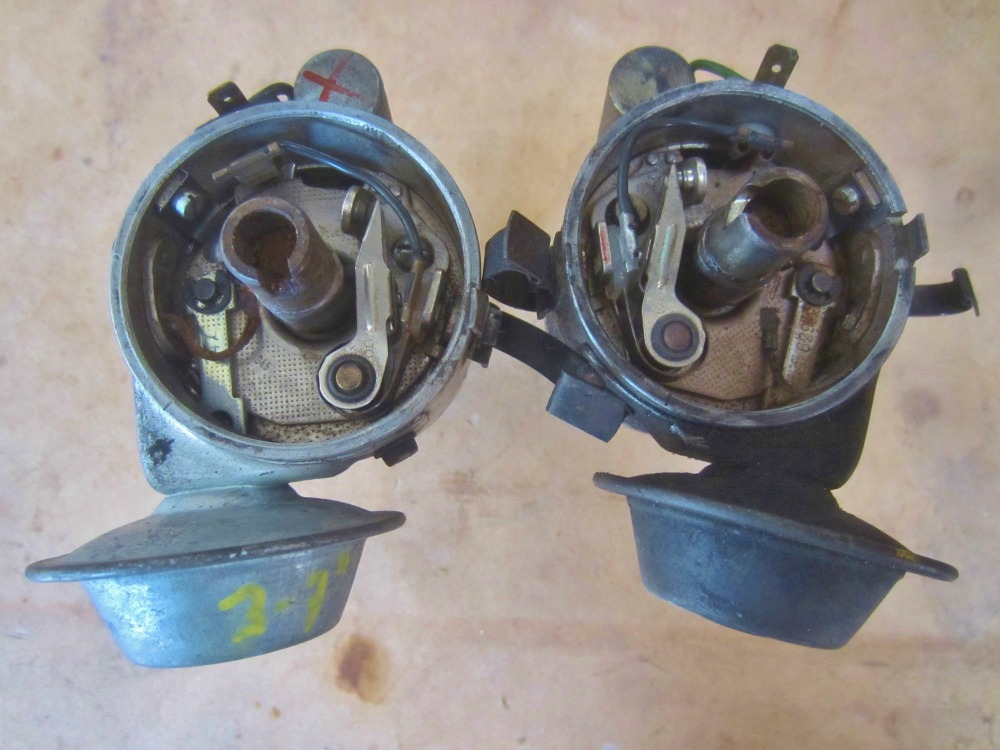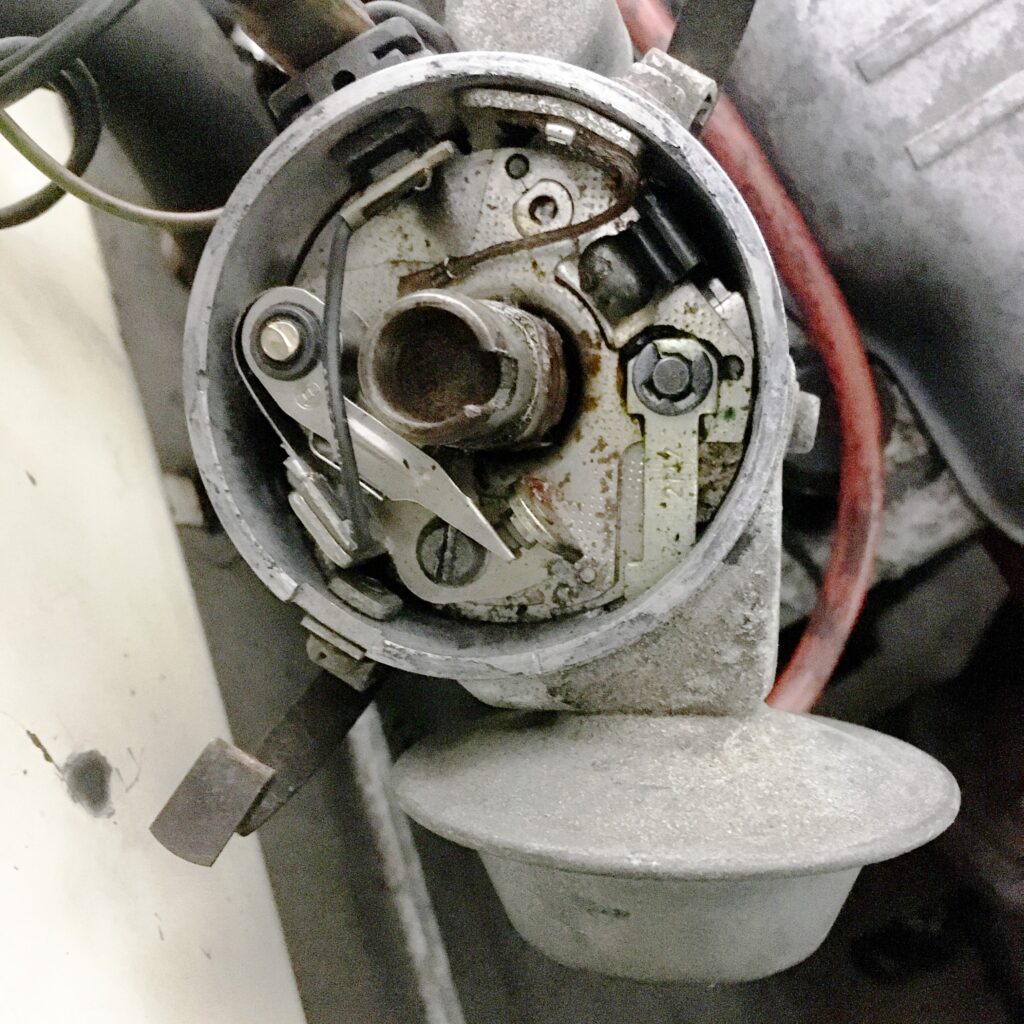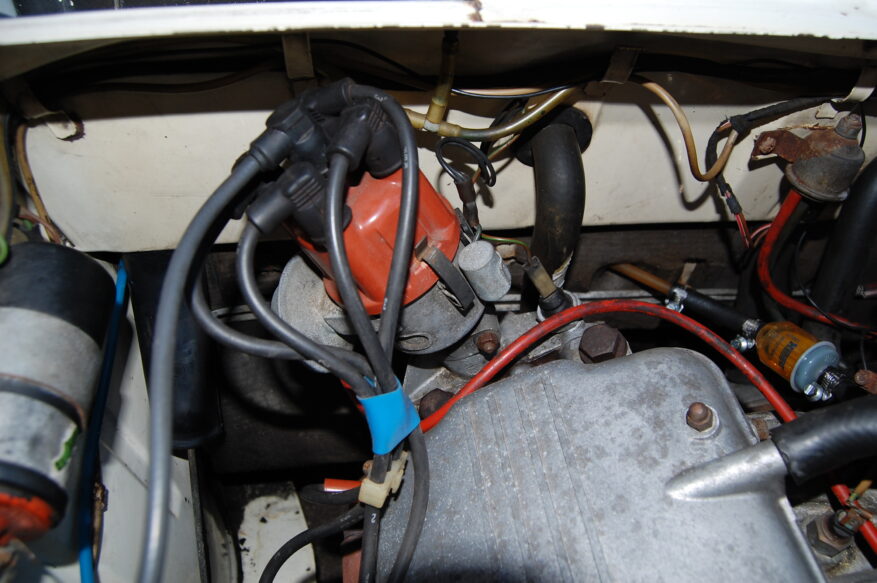The distributor in the photo below looks normal, but don’t let it fool you. It is evil. It is a mutant. It is an abomination.
Okay, let me back up.
One of the most common 2002 questions—after “What’s this car worth?” and “I changed X, Y, and Z ,and now it won’t start! HELP!”—is “What distributor should be in my car?” or its inverse, “What 2002 is this distributor for?” It’s an understandable question, as between the carbureted 2002s, the tii’s, the automatics, and the European and U.S.-spec cars, there was a dizzying number of distributors used, and the 2002 Owner’s Handbook lists only the short Bosch “J numbers” (example below) that are about as useful as going into a hardware store and saying that you want the white paint you saw in your neighbor’s kitchen.
You’d think that reading the ten-digit Bosch part number off the side of the dizzy and matching it up against the distributors listed in the 2002 Factory Manual (the blue binders) would get you a definitive answer, but it turns out that this is often not enough, as the factory manual is pretty short on details for U.S.-specific variants. If you search bmw2002faq.com for the individual part number, information on most of the dizzies can be found, but I don’t think that there’s a truly exhaustive authoritative correct easy-to-read 2002 distributor FAQ or table anywhere.

The section of the 2002 Owner’s Handbook listing the Bosch J-codes for the distributors. These tell you surprisingly little; you might as well expect describing your car as a sedan, a convertible, or a wagon to completely determine its year, make, and model.
For these reasons, whenever I’m asked the distributor question, I school the questioner in Siegel’s 2002 Distributor Taxonomy (trademark applied for, at least in my mind), which states that there are four main 2002 distributor configurations. You first need to appreciate that, unless you have a new whiz-bang $500 replacement distributor from 123 Ignition whose advance is determined electronically, all of the varieties of 2002 dizzies are Bosch distributors that use a conventional centrifugal advance mechanism (also called “mechanical advance”) where weights and springs inside the body of the dizzy cause the timing to advance (the spark to fire earlier) with increasing rpm, leveling out at some maximum value. There is usually also a circular vacuum diaphragm on the side that provides additional ignition advance, or retard, or both. Thus, the four main 2002 distributor configurations are:
-
- ’72 and ’73 2002tiis use a centrifugal-advance-only distributor (no vacuum diaphragm) and has less centrifugal advance than the other 02 distributors due to the fact that the tii’s injection system atomizes the fuel so well that it ignites and burns quicker than on a carbureted 02, thus requiring less advance. I believe that the dual-sidedraft-equipped 2002ti also used a straight centrifugal-advance dizzy, perhaps on the logic that those four individual butterflies fed well-atomized fuel into each of their cylinders.
- The ’74 tii used a vacuum-retard diaphragm that was fed a hose from a vacuum valve that was present on the air-cleaner housing of a ’74 tii. I long thought that the ’74 tii was the only 2002 that had vacuum retard, but I’ve seen parts books that say that the regular ’74 2002 had one as well.
- Due to the step increase in federally-mandated emission control standards, ’75 and ’76 2002s had vacuum diaphragms with both vacuum-advance and retard ports on them (advance on the outer part of the diaphragm housing, retard on the inner).
- EVERY OTHER DOWNDRAFT-CARBURETED 2002—so we’re talking 1968 through some point in 1973—used a vacuum-advance dizzy, though there were many different Bosch part numbers, the very early ones used different points, and there were differences in the advance curves.
Without wading way into the weeds, the J in the “J numbers” specifies the diameter of the body (they’re all the same size), the F specifies centrifugal advance (they all have it), R is a resistor-style rotor, D is a rev-limiting rotor, 4 is the number of cylinders, and U specifies the presence of a vacuum diaphragm, but it can be an advance diaphragm, a retard diaphragm, or both. Thus, while “JFR4” does specify the first configuration in my list—a tii centrifugal-advance-only dizzy—but “JFUR4” or “JFUD4” can apply to any of the last three.
This brings us to the other part of Siegel’s 2002 Distributor Taxonomy, which states that you don’t need to look up part numbers to know which of the four configurations you have, or to memorize which vacuum diaphragms are advance and which are retard, or which points are normal and which are “reversed,” because you can tell all of it by simply looking at the distributor:
- The distributor shaft of all 2002s rotates clockwise (I’m talking 2002s, not 320is). Therefore, when adjusting the timing, if you rotate the body of the distributor in the same direction the rotor is spinning, it makes the points open later. Conversely, rotating the dizzy in the opposite direction makes the points open earlier. Ergo, counter-clockwise rotation of the body advances the timing, and clockwise rotation retards it.
- Similarly, if you simply look at how the vacuum pod is attached, you can see that an arm comes out of the pod and clips to the plate that the points are mounted on. When vacuum is applied, that rod pulls the plate. Just like setting the timing, if the rod pulls the plate counter-clockwise, it advances the timing. If it pulls it clockwise, it retards the timing. So if you orient the dizzy so the pod is on the bottom, and you look at where it’s attached to the plate, if the attachment point is to the left of the distributor shaft, it’s a vacuum advance diaphragm (if the metal diaphragm housing has two ports, its both advance and retard), and if the attachment point is to the right of the shaft, it’s vacuum retard. If there’s no vacuum diaphragm, it’s a centrifugal-advance-only dizzy for a tii.
- The question about “normal” right-opening points versus “reversed” left-opening points falls out of this as well. Nearly every 2002 distributor used points that, when looked at so the pair of point contact faces are at the top, the nylon block that runs against the distributor shaft forces the points open to the right. The exception is the vacuum-retard dizzy where the arm from the vacuum diaphragm occupies the space where the points would normally go. So those dizzies have the points on the other size of the distributor shaft, and to make it work, the points are reversed—they open to the left instead of to the right. All of this is shown in the photo below.

On the left, a conventional vacuum advance dizzy with right-opening points, and on the right, a vacuum retard distributor with reversed left-opening points. Photo courtesy of “76mintgrun02” and bmw2002faq.com.
As I said above, I long had thought that the vacuum-retard dizzy was used only on the ’74 tii, but I found a post on BMW 2002 FAQ that had a scan of a 1986 Bosch ignition parts catalogue that listed the distributor for the ’74 tii and the ’74 2002 as using points whose part numbers correlated to “reverse” left-opening points, making it a certainty that the ’74 2002 dizzy was vacuum-retard as well. But while following that rabbit down the hole, I saw a post that said that some ’73 2002s also had a vacuum-retard dizzy.
Hmm.
My ’73 2002, “Hampton,” is a 49,000-mile survivor car. It’s not a complete testimony to originality—during its time with its original owner who had the car from new until 2019, the original double-barreled Solex was replaced with a Weber, and along with that, the emissions-related vacuum solenoids were left unhooked, and after I bought the car, I removed the non-functional EGR valve—but it’s still a pretty original car as 2002s go.
I grew curious about what dizzy was in it. Since it’s one of the cars that’s spending the winter in the garage instead of the warehouse on the Massachusetts-Connecticut border where I rent space, I could just run downstairs and have a look. So I did, and my jaw hung open.
This is what I found when I pulled off the cap and rotor. As per what I described above, the rod from the vacuum diaphragm attaches to the right side of the plate, so when it pulls the plate, it tugs it clockwise, which is in the direction the rotor spins, therefore it’s a vacuum-retard distributor. And since the rod is attached to the right side of the plate, the points are on the left side. However, if you look at the points in the photograph below, you’ll see that, unlike the points of the vacuum-retard dizzy on the right side of the photo above, these points are oriented upside-down, with the point contact faces oriented toward the vacuum diaphragm. If you rotate the photo 180 degrees so the points are oriented like the photo above, you’ll see that the points open to the right.
That is, this is a vacuum-retard distributor with standard right-opening points, something I did not know existed, a bastard child that violates Siegel’s 2002 Distributor Taxonomy.
WHAT THE HELL ARE YOU AND WHAT ARE YOU DOING IN MY CAR?

The mutant distributor.
I couldn’t see the Bosch part number on the side of the distributor body because it was facing the firewall, so I marked the side of the distributor and spun it around so that the number was readable. It’s 0 231 168 024, a number that doesn’t show up in the Factory Manual or the 1986 Bosch Ignition Parts catalog I linked to above.

Searching deeply on BMW 2002 FAQ, I did find a handful of references to this part number. Some said that it superseded 0 231 180 008, which I believe is the ’74 2002 vacuum-retard dizzy with “reverse” points. Other references said it was the other way around—that 008 superseded 024. I later found it in a very obscure Bosch document in which it was listed as applying both to a 2002 and a 2002 automatic.
Whatever it was, whatever it is, however it got into my car, really doesn’t matter nearly as much as the fact that I’ve been driving this car for the past three years and chasing an even-throttle drivability issue without realizing that I have a vacuum-retard distributor that has its vacuum diaphragm connected to the base of the carburetor as if it’s a vacuum-advance distributor, which means that, all this time, it’s having that diaphragm sucked on during idle and even throttle, which is typically where you want extra advance, not extra retard. Crikey.
At a minimum, I’ll disconnect and plug up the vacuum line before I drive the car again in the spring. Even better, I probably have a working vacuum-advance distributor kicking around the garage somewhere that would be more appropriate for the car than this vacuum-retard unit.
To paraphrase Monty Python, nobody expects the mutant distributor!—Rob Siegel
____________________________________
Rob’s newest book, The Best of The Hack Mechanic, is available here on Amazon, as are his seven other books. Signed copies can be ordered directly from Rob here.





















